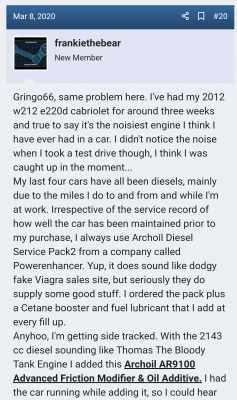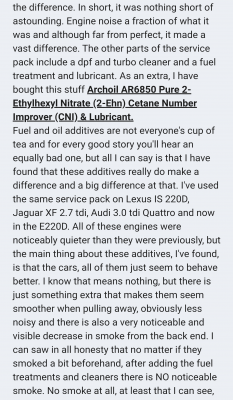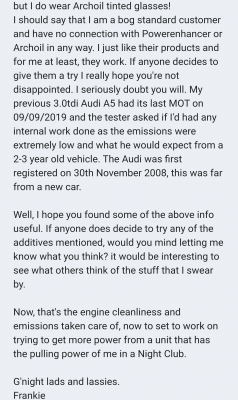oilman
Banned
We are asked all the time about the use of magic addatives / miracle cures.
This one is certainly no exception in its claims.
Having read about it, I asked Silkolene was this a miracle addative and were the claims possible or more importantly technically possible?
If you're interested in this sort of stuff, please read on as it's an eye-opener!
Quote: John Rowland (Silkolene's Chemist)
The mode of action of the ‘NanoLub’ particles is based upon a fallacy, i.e., that very small spheres can reduce friction and carry high loads by rolling between two moving surfaces, by analogy with ball bearings. (Their ‘Technical Note’ states: ‘NanoLub………….is extremely strong and rolls along surfaces to provide excellent lubrication. In fact, this simply does not happen due to effects that are not important at ‘macro’ scale, but significant at ‘micro’, and very important at ‘nano’ scales.
If an average size ball made of hard material rests on (for example) a toughened steel surface, it will make a small indentation. (Nothing is perfectly rigid, not even diamond.) If a force is applied to the ball, the depth of the indentation will increase, but so will its area; with a large ball, the area will be large relative to the depth. Provided that the elastic limit of the steel (Young’s Modulus) is not exceeded, the indentation will be restored to its original size when the force is removed. Thanks to this effect, precision ball and roller bearings have been successfully used for about 120 years. However, if a I micron (1000 nano-metres) diameter sphere is pressed into contact with a steel surface, the maximum possible area of the indentation will of course be equal to the maximum cross-sectional area of a 1 micron sphere, which is 7.9 x 10 to -13 square metres! In other words, a very light pressure will easily exceed the elastic limit of the steel and embed the sphere in its surface. Even 1mm hard steel balls, only used in very lightly-loaded ball bearings, have a cross-sectional area 1 million times greater. (The NanoLub particles are said to be 80 – 220 nanometres, or 0.08 to 0.22 microns in diameter.)
The embedding of hard particles into bearing surfaces is well known to bearing manufacturers, and its effects have been well understood for many years: by initiating micro-cracks and grain boundary dislocations, the fatigue life of rolling-element bearing surfaces is severely curtailed. All manufacturers insist that long bearing life depends upon clean oil or grease. There have been numerous studies published showing that particulates reduce bearing life, so NanoLub must not be used in any application where this type of bearing is used. (Similar effects occur between gear teeth.)
High-speed plain bearings as used in all present-day automotive engines depend upon ‘hydrodynamic’ lubrication, which depends upon thick (100 micron or more) fluid films generated by motion and viscosity. (This was researched by the Victorian engineer Beauchamp Tower in the late 19th Century). So particles smaller than 1 micron will have little opportunity to act as a lubricant in a much thicker oil film. Even so, embedding can occur at start-up/shutdown where ‘boundary’ thin film lubrication is dominant, leading to bearing damage. As with rolling bearings, hard particles in the oil are not a good idea, hence the use of oil and air filters on all engines made since about 1950.
The makers of NanoLub correctly point out that: ‘Common solid lubricants are layered compounds like graphite, molybdenum disulphide and tungsten disulphide. The layers slide past each other to reduce friction.’ Unfortunately, they seem to have failed to understand that layered solid lubricants act as lubricants only because they are layered. One sheet of graphitic carbon atoms for example is not a lubricant; two are! If a layered solid lubricant is treated in such a way so that its layers cannot move relative to each other, it cannot act as a lubricant, so the ‘nested sphere’ structure of NanoLub actually prevents it from acting as a lubricant.
In practice, I strongly suspect that the ‘nano-spheres’ actually disintegrate under high pressure, so the WS2 can act as a layered solid lubricant. (All rather ironic that NanoMaterials Inc. have gone to great lengths to stop WS2 working, and the only occasion when it has some effect is when the nano-particles break down!) Although they draw comparisons with the C60 buckminsterfullerene spherical ‘nano-particle’, this is a much smaller (0.7nano-metre) sphere which is a true molecule and consequently very resistant to fracture.
The ‘NanoLub Technical Note’ includes some wear test data, without stating the type of apparatus used. It is well known that some primitive wear testers such as the ‘Falex’ and ‘4-Ball’ generate unrealistically high pressures which do not replicate ’real-world’ conditions. (In the 1980s Shell published a table of wear test results ‘proving’ that milk and beer were superior lubricants to SAE 90 gear oil according to some types of wear test. I can send a copy I you wish.) The NanoLub tests are not very rigourous, using unspecified ‘Gear Oil 85W/140’ with and without the additive. A correct and believable procedure would involve using a mineral base oil with various levels of NanoLub, dispersed ‘conventional’ WS2, and a sulphur/phosphorus EP compound such as Anglemol 99. I confidently predict that properly controlled wear and friction tests using reputable apparatus such as the FZG Gear procedure would show NanoLub to be no more effective than conventional particle-free additives which act chemically or electrostatically, thus having no adverse effect on bearing life.
As a general comment, I find it difficult to believe that the founders of ‘ NanoMaterials Inc’ could be so ignorant of the vast amount of research and practical experience that has gone into lubrication problems over the past 200 years. Tomas Young, who researched the elasticity of materials around 1810, would have clearly understood the fallacy of very small ball bearings, for example. Any first-year Engineering student could have pointed out the pitfalls.
In common with many ‘magic additive’ advocates, there is also the curious belief that dry-lubricated bearings can operate at low friction. In fact, any reputable engineer avoids oil or grease-free bearings like the plague, because regardless of the coating used the friction is always ten times worse than an oil-lubricated situation, and over 100 times worse than a pressure-fed hydrodynamic bearing!
Even so, they’ve got a unit on the ‘Weizmann Science Park’ and a (virtual?) office in New York, so presumably somebody believes in them! But of course, looking on the Internet I see that they have the support of Wall Street, where fools are soon parted from their money.
Unquote:
I rest my case on magic addatives!
Cheers
Simon
This one is certainly no exception in its claims.
Having read about it, I asked Silkolene was this a miracle addative and were the claims possible or more importantly technically possible?
If you're interested in this sort of stuff, please read on as it's an eye-opener!
Quote: John Rowland (Silkolene's Chemist)
The mode of action of the ‘NanoLub’ particles is based upon a fallacy, i.e., that very small spheres can reduce friction and carry high loads by rolling between two moving surfaces, by analogy with ball bearings. (Their ‘Technical Note’ states: ‘NanoLub………….is extremely strong and rolls along surfaces to provide excellent lubrication. In fact, this simply does not happen due to effects that are not important at ‘macro’ scale, but significant at ‘micro’, and very important at ‘nano’ scales.
If an average size ball made of hard material rests on (for example) a toughened steel surface, it will make a small indentation. (Nothing is perfectly rigid, not even diamond.) If a force is applied to the ball, the depth of the indentation will increase, but so will its area; with a large ball, the area will be large relative to the depth. Provided that the elastic limit of the steel (Young’s Modulus) is not exceeded, the indentation will be restored to its original size when the force is removed. Thanks to this effect, precision ball and roller bearings have been successfully used for about 120 years. However, if a I micron (1000 nano-metres) diameter sphere is pressed into contact with a steel surface, the maximum possible area of the indentation will of course be equal to the maximum cross-sectional area of a 1 micron sphere, which is 7.9 x 10 to -13 square metres! In other words, a very light pressure will easily exceed the elastic limit of the steel and embed the sphere in its surface. Even 1mm hard steel balls, only used in very lightly-loaded ball bearings, have a cross-sectional area 1 million times greater. (The NanoLub particles are said to be 80 – 220 nanometres, or 0.08 to 0.22 microns in diameter.)
The embedding of hard particles into bearing surfaces is well known to bearing manufacturers, and its effects have been well understood for many years: by initiating micro-cracks and grain boundary dislocations, the fatigue life of rolling-element bearing surfaces is severely curtailed. All manufacturers insist that long bearing life depends upon clean oil or grease. There have been numerous studies published showing that particulates reduce bearing life, so NanoLub must not be used in any application where this type of bearing is used. (Similar effects occur between gear teeth.)
High-speed plain bearings as used in all present-day automotive engines depend upon ‘hydrodynamic’ lubrication, which depends upon thick (100 micron or more) fluid films generated by motion and viscosity. (This was researched by the Victorian engineer Beauchamp Tower in the late 19th Century). So particles smaller than 1 micron will have little opportunity to act as a lubricant in a much thicker oil film. Even so, embedding can occur at start-up/shutdown where ‘boundary’ thin film lubrication is dominant, leading to bearing damage. As with rolling bearings, hard particles in the oil are not a good idea, hence the use of oil and air filters on all engines made since about 1950.
The makers of NanoLub correctly point out that: ‘Common solid lubricants are layered compounds like graphite, molybdenum disulphide and tungsten disulphide. The layers slide past each other to reduce friction.’ Unfortunately, they seem to have failed to understand that layered solid lubricants act as lubricants only because they are layered. One sheet of graphitic carbon atoms for example is not a lubricant; two are! If a layered solid lubricant is treated in such a way so that its layers cannot move relative to each other, it cannot act as a lubricant, so the ‘nested sphere’ structure of NanoLub actually prevents it from acting as a lubricant.
In practice, I strongly suspect that the ‘nano-spheres’ actually disintegrate under high pressure, so the WS2 can act as a layered solid lubricant. (All rather ironic that NanoMaterials Inc. have gone to great lengths to stop WS2 working, and the only occasion when it has some effect is when the nano-particles break down!) Although they draw comparisons with the C60 buckminsterfullerene spherical ‘nano-particle’, this is a much smaller (0.7nano-metre) sphere which is a true molecule and consequently very resistant to fracture.
The ‘NanoLub Technical Note’ includes some wear test data, without stating the type of apparatus used. It is well known that some primitive wear testers such as the ‘Falex’ and ‘4-Ball’ generate unrealistically high pressures which do not replicate ’real-world’ conditions. (In the 1980s Shell published a table of wear test results ‘proving’ that milk and beer were superior lubricants to SAE 90 gear oil according to some types of wear test. I can send a copy I you wish.) The NanoLub tests are not very rigourous, using unspecified ‘Gear Oil 85W/140’ with and without the additive. A correct and believable procedure would involve using a mineral base oil with various levels of NanoLub, dispersed ‘conventional’ WS2, and a sulphur/phosphorus EP compound such as Anglemol 99. I confidently predict that properly controlled wear and friction tests using reputable apparatus such as the FZG Gear procedure would show NanoLub to be no more effective than conventional particle-free additives which act chemically or electrostatically, thus having no adverse effect on bearing life.
As a general comment, I find it difficult to believe that the founders of ‘ NanoMaterials Inc’ could be so ignorant of the vast amount of research and practical experience that has gone into lubrication problems over the past 200 years. Tomas Young, who researched the elasticity of materials around 1810, would have clearly understood the fallacy of very small ball bearings, for example. Any first-year Engineering student could have pointed out the pitfalls.
In common with many ‘magic additive’ advocates, there is also the curious belief that dry-lubricated bearings can operate at low friction. In fact, any reputable engineer avoids oil or grease-free bearings like the plague, because regardless of the coating used the friction is always ten times worse than an oil-lubricated situation, and over 100 times worse than a pressure-fed hydrodynamic bearing!
Even so, they’ve got a unit on the ‘Weizmann Science Park’ and a (virtual?) office in New York, so presumably somebody believes in them! But of course, looking on the Internet I see that they have the support of Wall Street, where fools are soon parted from their money.
Unquote:
I rest my case on magic addatives!
Cheers
Simon

 . The idea behind this was that the teflon would 'fill up the gaps', and form a (more) frictionless surface and claims were made (though obviously NOT advocated) that cars had been run for several hundreds of miles without oil.
. The idea behind this was that the teflon would 'fill up the gaps', and form a (more) frictionless surface and claims were made (though obviously NOT advocated) that cars had been run for several hundreds of miles without oil.



